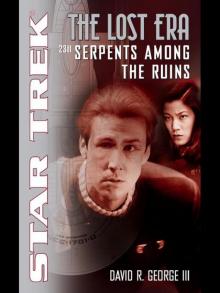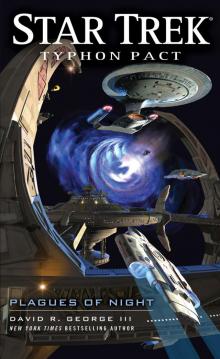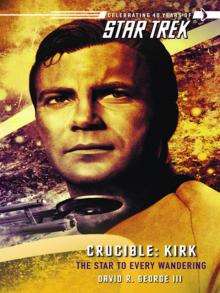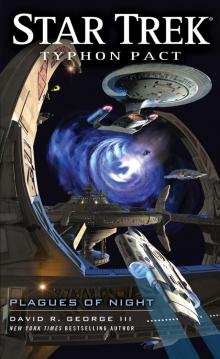- Home
- David R. George III
Star Trek: Typhon Pact: Plagues of Night Page 5
Star Trek: Typhon Pact: Plagues of Night Read online
Page 5
In the short time that Kamemor had held her high office, the work seemed to rejuvenate her sister’s grandson, whom she had appointed proconsul. Though several decades her junior, Anlikar Ventel’s mop of gray hair and his wizened face always made him appear older than she. They shared a vague family resemblance, most noticeably in the gray hue of their eyes. When Kamemor approached him about joining her in the upper stratum of government, he accepted with vigor, noting his excitement about the new praetor’s personal tendency to seek out all opinions when deciding an issue. So far, in a small sample size, Ventel had disagreed with Kamemor on a number of issues, and he’d already succeeded on one occasion in convincing her to adopt his position over her initial stance.
The second man appeared somewhat younger than Ventel, though he cut a similarly tall, lean figure. Unlike Kamemor’s grandnephew, who wore semiformal but understated attire, Tomalak chose to wear a tailored, black-and-gray suit echoic of an Imperial Fleet uniform, undoubtedly intended to underscore his lengthy military record. The former starship commander clearly believed in political opportunism, and it seemed to Kamemor that he sought to impress the relatively new leader of the Tal Shiar, with whom the praetor had called the meeting about to take place.
“Gentlemen,” said Kamemor, “thank you for coming.” Her manners might have appeared deferential to some, perhaps even beneath her station, but she had learned such civility at her father’s knee. It proved a valuable asset during her extensive career in the diplomatic arena, though in truth, she wielded her courtesy less as a tool than simply as a habit of long standing.
Ventel bowed his head in acknowledgment, while Tomalak proffered an unctuous smile. “It is always a privilege to provide counsel,” said the latter.
Kamemor did not hold Tomalak in particularly high regard. Before his selection by Tal’Aura as her proconsul, he spent decades in the Imperial Fleet, his time there marked by steady, if plodding, advancement. While hardly a dullard, he did not impress her with his mental faculties. Still, he had demonstrated his skills in developing and implementing broad strategies for the military, even as he pursued a personal agenda.
When Kamemor had accepted the praetorship, she had met with Tomalak, who immediately and expectedly offered his resignation as proconsul. He spoke of his desire to return to his life in the Imperial Fleet, and Kamemor’s subsequent public statement about his stepping down reflected that. Later, though, she reconsidered. She genuinely believed that in order for her to lead well, she needed to consider a divergence of viewpoints, especially those of people with whom she did not typically concur. She also trusted in the old aphorism: A well-fed serpent at home threatens less than a hungry one in the wild. So, she had reversed course and invited Tomalak to stay on in her cabinet as an advisor, as a second proconsul to serve alongside Ventel.
Kamemor moved to the center of the room and paced the length of the conference table. As Ventel and Tomalak followed, she asked, “Have you learned anything more about the incident?” She stopped at the far end of the table and turned to face them.
“Starfleet is reporting to the news agencies that the explosions at their Utopia Planitia facility occurred as the result of an industrial accident,” Ventel said.
“An industrial accident?” Kamemor repeated. She gestured to the chairs to her left and right, and the two men sat down. The praetor took the seat at the head of the table, placing the throne at her back, and thus out of her line of vision, which pleased her. “Do we believe them?”
“It’s difficult to know what to believe,” Ventel said. “The Federation is offering few details about what took place, beyond citing more than a hundred dead and injured. But Starfleet has little history of accidents like this.”
“Not recently, no,” Kamemor said, thinking of an event that had transpired nearly three-quarters of a century earlier. On that occasion, Starfleet’s flight testing of a new type of starship drive had ended in disaster, with the destruction of the test bed and its entire crew. But that had happened decades ago. She turned her gaze toward Tomalak.
“I’ve reviewed the recent reports of all our vessels along the Federation borders,” he said. “There’s no indication that any neighboring powers, within or without the Typhon Pact, have penetrated into their space.”
“So you believe that it was an accident,” Kamemor said, aware that she sought confirmation of what she hoped to be true.
“I neither believe nor disbelieve,” said Tomalak. “The Federation cannot be trusted, either in their assertion of alleged facts or with respect to their motives for doing so. The wisest course is to proceed as you’ve ordered: find out and verify as much as we can for ourselves.”
“So what precisely do we know with certainty?” Kamemor asked, looking to both of her proconsuls.
“Not much, really,” Ventel said. “We—”
The door chime interrupted the meeting, a few moments earlier than expected. Kamemor rose from her chair, and Ventel and Tomalak followed suit. The doors opened, and Uhlans Preget and T’Lesk escorted in the chairwoman of the Tal Shiar. This time, the two guards remained inside the room when they closed the doors. In light of the political turmoil of the recent past, the Continuing Committee had ordered that only members of the praetor’s cabinet could meet with Kamemor without the presence of at least two armed guards.
The chairwoman strode purposefully into the room. She wore the standard uniform of the Romulan intelligence agency: a light gray, simply patterned top with squared shoulders, with slacks and boots shaded a darker gray. A strap rose from her belt and up her torso, splitting at her chest and angling across her shoulders, the right-hand branch doubled. In one hand, she carried a data tablet. She did not stop at the far end of the table, but continued on toward the praetor and her advisors. Shorter by ten or so centimeters than either Ventel or Tomalak, Sela nevertheless projected an air of confidence and strength.
She’d have to, Kamemor thought. Despite ears that tapered upward to Romulan tips, Sela’s countenance more resembled that of a human. Though she wore her hair in a traditional Romulan style, her blond locks fell well outside the color norm. Her lack of upswept eyebrows and forehead ridges also marked her mixed parentage. And yet she’s succeeded on Romulus, within a deeply insular culture, Kamemor thought. In some ways, Sela’s rise to power reminded her of Shinzon, a full-blooded human who’d managed to enthrall enough followers to stage a bloody overthrow of the Imperial Senate and Praetor Hiren, and then to launch an attack on the Federation. While Sela’s personal record demonstrated her own antipathy for the UFP, though, she had also proven herself loyal to the Romulan government.
“Chairwoman Sela,” Kamemor said as the head of the Tal Shiar stopped beside Ventel. “Thank you for your prompt response to my request for a meeting.”
“Of course, Praetor,” Sela said. “I am always at your disposal.”
“Please,” Kamemor said, indicating the chairs. Once everybody sat, she said, “What can you tell us about the incident in the Federation?”
Sela set her data tablet down on the table, its display blank. “First, that there was an incident,” she said. “We have observers and contacts within the Federation, and we’ve obtained independent corroboration of the two explosions at the Starfleet construction installation.”
“And what of Starfleet’s characterization of the event as an industrial accident?” Kamemor wanted to know.
“The truth of that is less clear,” Sela said.
Kamemor had anticipated that news. “I am troubled by that.”
Ventel tilted his head to one side. “May I ask what in particular troubles you?”
“My primary concern,” Kamemor said, “lies with Starfleet’s quantum slipstream drive.”
“You worry that they are attempting to transform their engine technology into a weapon,” said Tomalak, forming an inference from the praetor’s words, and perhaps divulging his own suspicions.
“No,” Kamemor said. She had dealt with the Federation en
ough in her life to know that, while they practiced their own insidious brand of political and social imperialism, they did not spark to war without just cause, nor did they seek to disturb the delicate equilibrium that maintained peace among the powers of the Alpha and Beta Quadrants. What she suspected, though, would almost certainly meet with resistance among those she’d assembled. She folded her hands together on the table. “I am concerned about the slipstream drive,” she said, “but not about the Federation.”
Tomalak looked confused—almost comically so. He glanced over at Ventel and Sela in turn, then back at the praetor. “I don’t understand.”
“Another power,” Sela said, more statement than question. “You think that some other power may have been trying to steal the slipstream plans.”
“Yes,” Kamemor said, impressed but not surprised by the chairwoman’s easy acumen. “The Federation has been utilizing their advanced drive technology for some time now without employing it to threaten the Empire or the Typhon Pact. We can therefore draw a positive conclusion about their motives.”
“I’m not certain that the Tzenkethi would agree,” Tomalak interjected before the praetor could complete her thought. “I’m not sure that I agree.”
“The Tzenkethi complain about virtually everything the Federation does,” Ventel said. “Believe me, if the autarch thought that Starfleet’s slipstream-equipped vessels endangered his people, he’d be demanding that the rest of the Pact launch a preemptive offensive.”
“Or,” Sela said, deftly returning the conversation to the point Kamemor sought to make, “Autarch Korzenten would attempt to acquire the slipstream drive for the Tzenkethi Coalition.”
“That is one of my concerns,” Kamemor said. “Not necessarily that the Tzenkethi mounted an espionage mission, but that some nation did.”
Ventel nodded. “If one of the powerful independent states, such as the Watraii or the Gottar or the Patriarchy, obtain the slipstream technology, it could destabilize the region.”
“It could,” Tomalak agreed. “And that could cause problems for the Empire. But with the combined resources of the Typhon Pact, isn’t such a threat one that we could effectively contain?”
“What if it’s not one of the independent states,” Kamemor asked, “but one of our own allies? What if it was the Tzenkethi?”
Tomalak’s eyebrows rose in evident surprise. Through a smug smile, he said, “That would be a boon, of course.”
“Would it?” Kamemor said. She pushed back from the table and stood up. “It would prove that one or more of our allies is willing to commit an act of war without even notifying us, let alone seeking our consultation and approval.”
“We could be facing destabilization not only in the region,” Ventel said, “but within our own alliance.”
“Yes,” Kamemor said, “but even that is not what most concerns me.” She turned from the table and paced away. Her gaze passed once more over the throne. She hoped that what she viewed as a symbol of Romulan hubris would not mirror what had actually transpired at Utopia Planitia. Turning back toward the proconsuls and the Tal Shiar chairwoman, she said, “Starfleet reported explosions and an industrial accident, and nothing more. That means that whatever truly happened, nothing took place that they couldn’t hide.”
“What … ?” Tomalak started, clearly missing the implication of Kamemor’s words. Sela apparently did not.
“No one saw an alien vessel there,” said the chairwoman. “Which means that if this wasn’t an accident, if it was an attempt to steal plans for the slipstream drive and there was a ship, then it was cloaked.”
“The Klingons?” Tomalak asked, his inability to follow the thread of the argument seeming almost willful.
“Not the Klingons,” Kamemor said, walking back over to the head of the conference table. The tips of her fingers brushed its polished surface. “The Klingons are allies with the Federation, and their cloaks are primitive enough that, with the proper effort, Starfleet can detect their vessels.”
“Besides,” Ventel noted, “whether the Klingons appropriate the slipstream drive or the Federation hands it to them, it would not alter the balance of power.”
Silence descended in the chamber, and Kamemor hoped that the group she’d gathered together followed the chain of reasoning she’d put forth. She did not want to be the one to utter the conclusion she had reached. Sela did not disappoint her.
“You’re concerned about Romulan involvement,” she said.
Kamemor locked eyes with the Tal Shiar chairwoman. “I am unaware of any such involvement,” said the praetor, “and so, yes, the possibility concerns me greatly.” She slowly sat back down.
Ventel peered over at her, his expression grave. “The Empire did provide cloaking devices to the other members of the Typhon Pact,” he said.
“Most of whom have been unable to adapt the technology effectively to their space fleets,” Sela said. “And if I understand correctly, Praetor Tal’Aura waited to share the cloak with our allies until our engineers had achieved for ourselves the next step in its development.”
“So while the Breen and the Gorn and the other powers now possess the ability to cloak their ships, at least in theory,” Kamemor said, “the Empire retains the most advanced cloak, one far less likely to be detected by the Federation.”
“Has the new cloak even been deployed?” Ventel asked.
“On a moderate number of ships, yes,” Tomalak said. “But the Imperial Fleet’s standing orders are not to use the new technology. Praetor Tal’Aura wanted the tactical advantage available if needed, but did not wish to risk revealing even its existence unless absolutely necessary.”
“A policy I have continued,” Kamemor said.
“Are you suggesting that a Romulan commander violated orders and used the new cloak to commit an unsanctioned act of espionage against the Federation?” Tomalak asked. His tone conveyed his skepticism.
“I am suggesting that is one possibility among several,” Kamemor said. “And that’s the point: we don’t know much for certain. It’s possible that Starfleet really did suffer an industrial accident. It’s even possible that the explosions occurred as the result of an attempt to create a new, powerful weapon.” Kamemor remembered well a similar claim levied against the Federation by the Klingons decades earlier—a claim politically motivated and false, but not entirely without justification. “We need to identify more than possibilities. Whatever happened at Utopia Planitia could have implications for the Empire.”
“As I said, we have assets within Federation space,” offered Sela. “I’ll make full use of them.”
“Do so,” Kamemor said, “but I want no deeds that could be considered an act of aggression against the Federation.”
“Just having operatives within their territory could be considered aggressive,” said Tomalak.
“I think not,” Kamemor said. “Not only does our Empire host Federation citizens within our borders, but we allow them to openly dissent. The UFP’s former ambassador, Spock, continues to foment the idea of reunification between Romulus and Vulcan.” The praetor stood from her chair. “Chairwoman Sela, pursue whatever leads you can find among our assets inside the Federation. Proconsul Tomalak, I want you to use your contacts within the military to see if you can confirm or refute Romulan participation in what took place. I will meet with Fleet Admiral Devix to gather what information I can from him.” Kamemor did not relish conferring with Devix, a hard man who had risen to command the Romulan military after the failures of its previous head. “Proconsul Ventel, you will collate all of the information we gather until we have a complete picture of what occurred at Utopia Planitia.”
Ventel, Tomalak, and Sela all acknowledged their assignments. Kamemor stood up again, this time to signal an end to the meeting. “Thank you, all,” she said. The three visitors rose from their chairs, Sela scooping up the data tablet she’d brought with her, but which had gone unused. They made their way back along the conference table to the other si
de of the chamber. Uhlans Preget and T’Lesk pulled open the doors, allowing them to exit. Once Ventel, Tomalak, and Sela had gone, the two security officers turned back toward Kamemor.
“Will there be anything more, Praetor?” T’Lesk asked.
“No,” Kamemor said. “You may return to your posts.”
The two uhlans left the chamber, closing the doors behind them.
Kamemor stepped away from the table and headed around the platform upon which the throne sat, toward the door hidden behind it that led to her personal office. She could not prevent herself from regarding the ostentatious display of authority exhibited by the great chair. The idea of such obvious power, so distasteful to her in the way that it for so long had been applied in Romulan society, seemed to mock her. Though she did not crave leadership, neither did she wish to be deposed. Having risen to the office of praetor, she wished to fashion her government into a tool that would help all the people of the Empire, and not merely its elite. Under the best of circumstances, she faced a difficult task, but if her suspicions proved correct—if members of the Romulan Imperial Fleet had attacked a Federation facility without her knowledge or approval—she might soon be facing a coup.
In that case, Kamemor knew, she might not even be able to help herself.
June 2382
4
Sisko delivered his report directly to the commander of Starbase 39-Sierra. The stone-faced Admiral Philip Herthum seemed to listen intently, his hands out before him, palms lying flat on the surface of his desk. Crafted of a rough-hewn, tightly grained wood, the large piece of furniture fit well with the nature-inspired design of the office, Sisko thought. Slate flooring and paneled walls also tied into the theme. Set into a side wall, a mammoth picture window, easily the room’s dominant feature, looked out toward the vast span of the Ravingian Mountains in the west. Still early in the day, the morning sun illuminated the impressive range, from its snowcapped peaks to the timberline running along its base.

 Serpents Among the Ruins
Serpents Among the Ruins The Fire and the Rose
The Fire and the Rose Star Trek: Typhon Pact 06: Plagues of Night
Star Trek: Typhon Pact 06: Plagues of Night Star Trek: The Lost Era - 08 - 2319 - One Constant Star
Star Trek: The Lost Era - 08 - 2319 - One Constant Star Star Trek: Deep Space Nine: Ascendance
Star Trek: Deep Space Nine: Ascendance Star Trek: TOS: Allegiance in Exile
Star Trek: TOS: Allegiance in Exile Crucible: Kirk
Crucible: Kirk Crucible: McCoy
Crucible: McCoy The Long Mirage
The Long Mirage Original Sin
Original Sin Star Trek: Typhon Pact: Plagues of Night
Star Trek: Typhon Pact: Plagues of Night Allegiance in Exile
Allegiance in Exile Sacraments of Fire
Sacraments of Fire Star Trek: Typhon Pact: Rough Beasts of Empire
Star Trek: Typhon Pact: Rough Beasts of Empire Star Trek: The Fall: Revelation and Dust
Star Trek: The Fall: Revelation and Dust